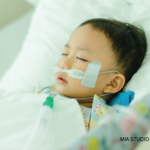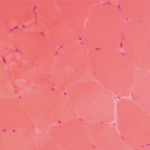The Case
An 11-year-old Caucasian female with juvenile dermatomyositis (JDMS) presented to our clinic with a worsening rash and increased proximal muscle weakness. Three years prior to this visit, the patient had been diagnosed with JDMS based on clinical presentation, elevated muscle enzymes, and characteristic findings on muscle biopsy and electromyography. She was successfully managed with chronic oral corticosteroids and weekly oral methotrexate.
Six months prior to her initial visit in our clinic, the patient developed a recurrence of her heliotrope rash and Gottron’s papules of her hands and knees. She also experienced worsening proximal muscle weakness, with difficulty brushing her hair, walking up and down stairs and standing up from a seated position. Magnetic resonance imaging (MRI) of her thighs revealed diffuse T2 signal abnormalities bilaterally, consistent with myositis. Tests with abnormal results included a creatine kinase of 383 U/L (60–230 U/L), aldolase of 13.2 U/L (1.2–11.8 U/L), lactate dehydrogenase of 1,042 U/L (340–700 U/L), neopterin of 71.4 nmol/L (2–10 nmol/L), and immunoglobulin G (IgG) of 1,810 mg/dl (524–1,403 mg/dL).
In view of these findings, the patient was started on a new treatment regimen that consisted of subcutaneous methotrexate at a higher dose, oral corticosteroids, and azathioprine. Nevertheless, the patient continued to have a rash and progressive muscle weakness. A decision was therefore made to start treatment with intravenous pulse corticosteroids and monthly high-dose intravenous immunoglobulin (IVIg) infusions. Immediately following the start of this treatment, the patient noticed marked improvement in both her rash and strength. Her muscle enzymes normalized after three months of IVIg therapy, and she was able to ride a bicycle for the first time in two years. Her cutaneous findings subjectively improved after four months of IVIg therapy, and her neopterin level normalized after 12 months. She maintained remission on monthly high-dose IVIg infusions and stable methotrexate dosing with continued tapering of the oral corticosteroids. Her IVIg therapy was discontinued after 14 total infusions, and her JDMS has remained quiescent on subcutaneous methotrexate and hydroxychloroquine.
Introduction
IVIg is a highly purified globulin preparation obtained from the pooled plasma of thousands of healthy donors. Although initially given as replacement therapy for patients with primary and secondary immunodeficiency states, IVIg has proven to be effective in the treatment of various autoimmune and inflammatory disorders. This success has led to a dramatic increase in the use of IVIg, with its use as an antiinflammatory agent now vastly surpassing its use in the treatment of immunodeficiencies. In fact, approximately 70% of IVIg administered today is for immunomodulation in patients with autoimmune disease.1 Even so, the basis for the antiinflammatory activity of IVIg remains unclear. While multiple modes of action have been proposed, there may not be a single effect and the different proposed actions may not be mutually exclusive. This article will review some of these mechanisms, preceded by a brief discussion of clinically relevant aspects of IVIg therapy.


